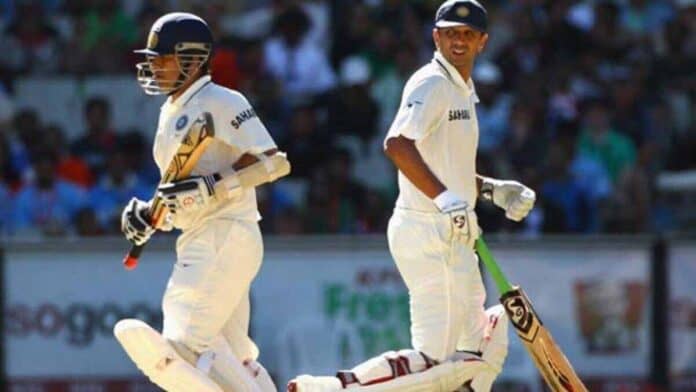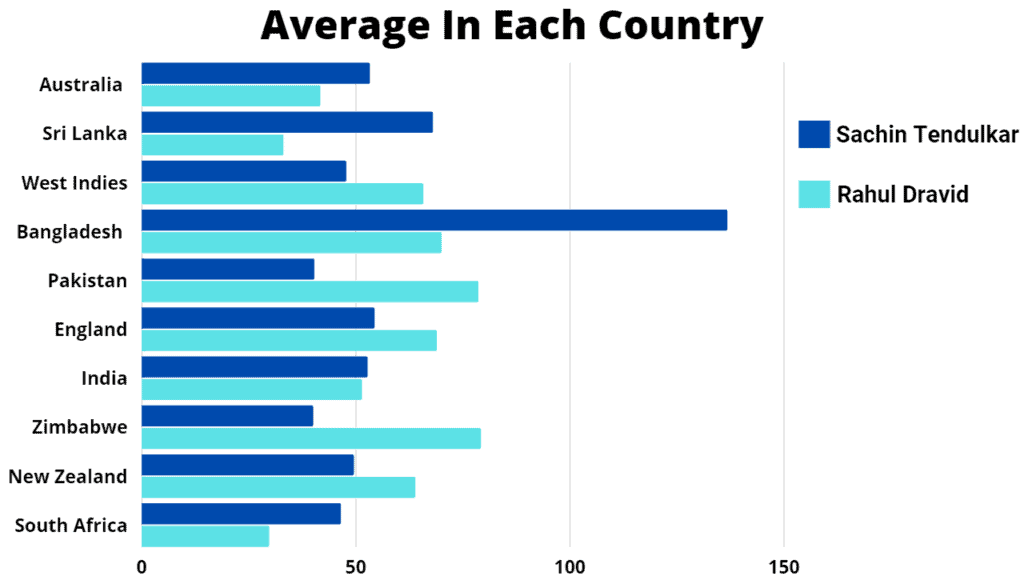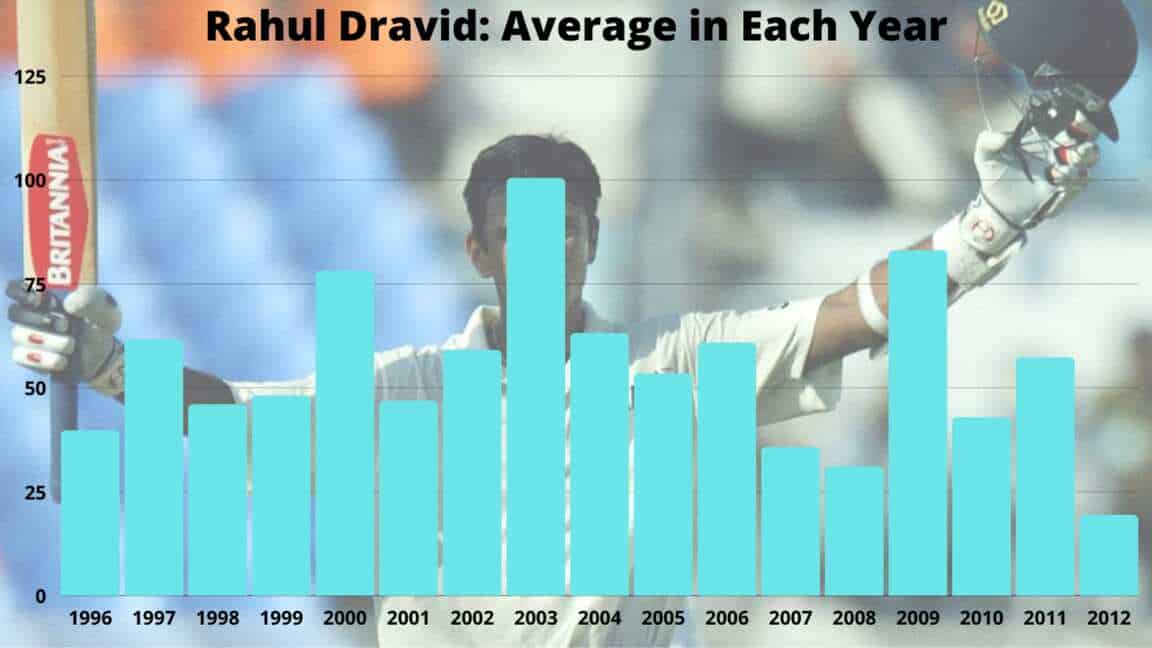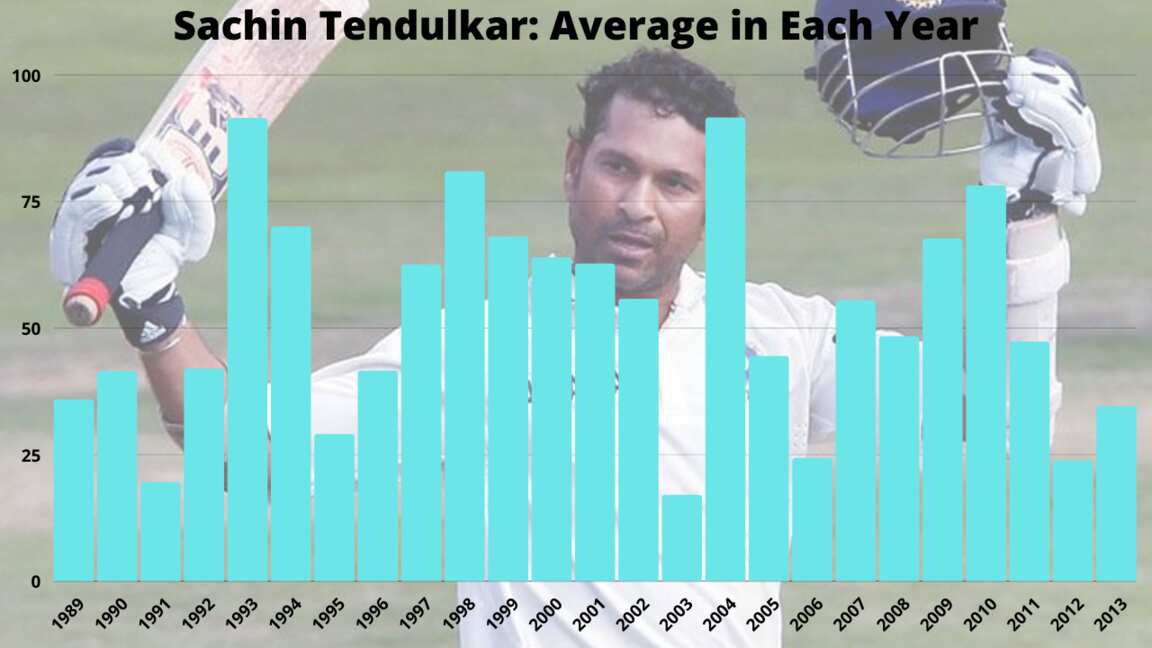Let’s start this with a question? Who is The Greatest Test Batsman India has ever produced?
The answer may vary, but legit followers of the game cant reply other than the following three:
- Sunil Gavaskar
- Sachin Tendulkar
- Rahul Dravid
Gavaskar played in a different era, and maybe that’s the talk of another day, but today, we will concentrate on our main topic, which is to find the answer to a widespread debate: who among Dravid and Sachin is a superior test batsman?
Tendulkar played this format for 24 years, While Dravid played for 16 years.
Sachin relied on a varied range of shots. He could drive the ball straight, hook you for a six, and his cut shot was a treat to the eyes.
Rahul Dravid was regarded as “The Wall” and famously known for his defence, but his flick shot was considered the best played by a cricketer.
Both combined scored 29,209 Test runs and 87 Test centuries (The highest for a batting pair).
Dravid was not as good as Tendulkar in ODIs (to be honest, no one in that era was), but the debate about who is better in test cricket is never-ending.
Both almost played in the same era and faced much more similar bowling attacks and conditions, making comparing them simple and completely valid.
We will discuss various topics/questions in this article, such as who was:
- Better in Home Conditions?
- Better Away From Home?
- More Consistent?
- Better in Tougher Conditions?
- More Versatile?
- Better in Won Matches?
Who Performed Better in Home Conditions?
Rahul Dravid has scored 5,598 runs in 120 innings with an average of 51.35 (RPI=46.65) while playing in India (Home conditions)
On the other hand, Sachin Tendulkar has scored 7,216 runs in 153 innings with an average of 52.67 (RPI=47.16) in India.
Dravid managed to hit 15 centuries in that 120 innings, which means he takes an average of 8 innings to hit a century in Home conditions.
Tendulkar scored 22 centuries in 153 innings and took an average of 6.95 innings to score a century under the same conditions.
So, in home conditions, Sachin has a slightly better average, higher RPI and takes fewer innings to score a century compared to Rahul Dravid.
Who Performed Better Away from Home?
In the 166 innings played by Dravid (away from home), he managed to score 7690 runs with an average of 53.03 (RPI=46.32)
Under the same criteria, Tendulkar has scored 8705 runs in 176 innings with an average of 54.74 (RPI=49.46)
Dravid has 21 centuries away from home in that 166 innings, which means a century in 7.9 innings.
Sachin also leads here, having scored 29 centuries in 176 innings, a century every 6.06 innings.
So, again, in the end, Sachin has a better average and higher RPI and also takes way fewer innings to score centuries away from home than Dravid.
Who Is More Versatile?
Against Swing
This chart indicates that Dravid seems to be more comfortable than Tendulkar in countering swing. His average is higher in both New Zealand (63.83) and England (68.8) compared to Tendulkar’s average of 49.53 and 54.31 in these countries, respectively.
Against Pace and Bounce
Sachin is significantly better than Dravid in handling pace and bounce. He averages way better in both South Africa (46.44) and Australia (53.21) than Dravid, who averages 29.71 and 41.64 in both countries, respectively.
Against Spin
In the art of playing spin, Tendulkar also holds an upper edge as he is regarded as one of the best players of spin bowling in the last 30 years, and his statistics also justify this tag.
In Asian conditions (excluding home), Sachin has scored 2458 runs in 41 innings with an average of 70.22, while Dravid has scored 1772 runs in 40 innings with an average of 50.62.
Also, in the home of the best spin bowling attack of that time (Sri Lanka), Dravid scored just 662 runs in 21 innings with an average of 33.10, Whereas Tendulkar scored 1155 runs in just 19 innings with an average of 67.94.
Also, Dravid has below-average stats in some countries (South Africa and Sri Lanka).
On the other hand, Sachin’s average didn’t fall below 40, even in a single country.
Who Is More Consistent?
Note: While comparing consistency, we exclude the years in which the batsman has played less than 5 innings. So, in our case, we will not count Sachin’s 1991 and 1995 stats in this section.
In the 23 years of his Test career (excluding 1991 and 1995), Sachin averaged less than his overall average in 10 years, which is 43.47% of his career years.
Dravid, on the other hand, averaged below his overall average in 9 years of his 17-year Test career, which is 52% of his career years.
If we take 40 as a standard average, Tendulkar averages less than 40 in 5 years of his career, or 21.73% of career years.
Dravid failed to maintain the average of 40 in 4 years, for 23% of his career years.
Rahul takes an average of 2.88 innings to score a 50 (99 50+ scores in 286 innings).
Whereas Sachin takes 2.76 innings to score a 50 (119 50+ scores in 329 innings)
Who Performed Better in Tougher Conditions?
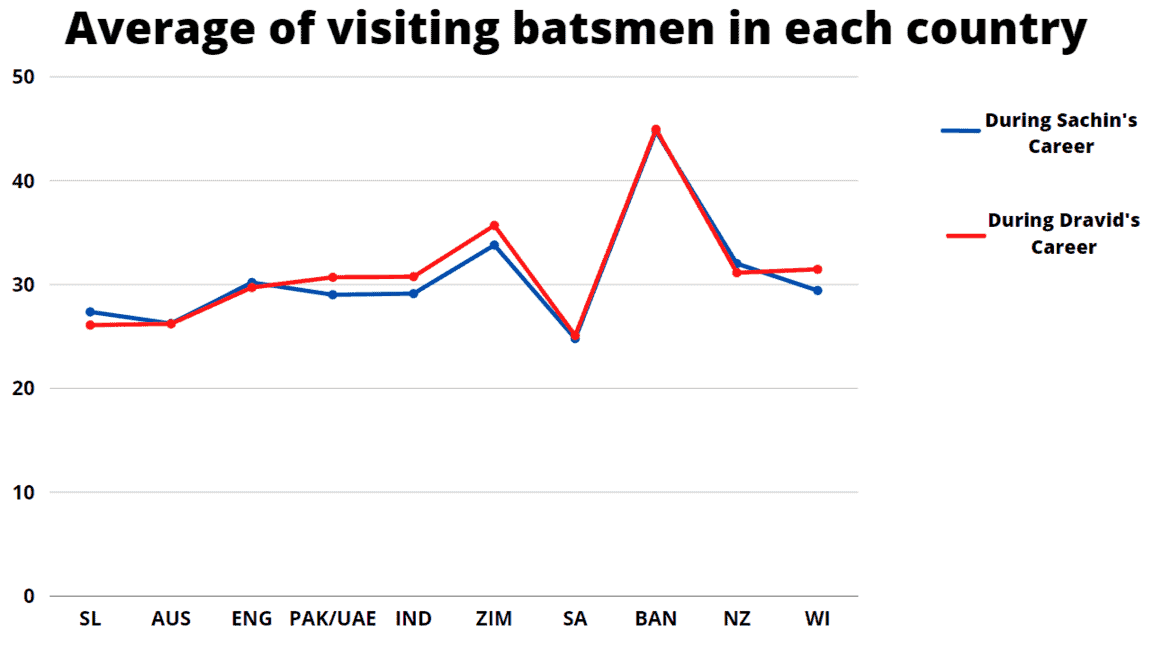
According to the graph of the mean average of visiting batsmen in each country (given above), Sri Lanka, Australia, and South Africa are the toughest countries for visiting batsmen during both playing days.
Now, if you see Rahul Dravid’s Performances by country (Discussed in the versatility part), you will notice that Dravid is a beast in almost all countries except Sri Lanka, Australia, and South Africa, where he averages 33.10, 41.64, and 29.71, respectively. Quite a coincidence!!
In the case of Sachin, He averages 67.94 (SL), 53.21 (AUS), and 46.44 (SA) in the same criteria.
To understand how big the difference is, Sachin Tendulkar has played 85 innings in these three countries where he managed to score 4125 runs in 85 innings with an average of 54.27 (RPI=48.52)
In the same criteria, Rahul Dravid scored 2452 runs in 75 innings with an average of 35.53 (RPI=32.69).
Dravid has 3 centuries in that 75 innings, which means a century in every 25 innings; however, Sachin scores a century in almost every 5.3 innings (16 centuries in 85 innings).
An average difference of almost 20 and an RPI difference of almost 16 clearly indicate that the difference here is massive. The rest of the work is done by innings taken per century.
Who Performed Better in Matches Won by India?
Although this criterion has too many flaws, an individual batting performance is not usually enough to win a match for his team, especially in the longest format of the game.
For example, a player can perform in much more challenging conditions where his team’s chances of winning the match are too low, while the other player can score better than him in more manageable conditions. In the end, some people will call the second one better because his runs came in winning cause.
This criterion can never tell the whole story, so it should not be given much importance when comparing two batsmen (in an ideal world, we should not consider numbers like these)
Still, we will compare both players’ stats in won matches to get a complete overview of this topic.
Overall, Sachin has played 113 innings in won matches where he scored 5946 runs with 20 centuries (Avg=61.93, RPI=52.61, Inn/100=5.65)
In 92 innings, Dravid scored 5131 runs with 15 centuries in the same filter (Avg=65.78, RPI=55.71, Inn/100=6.13).
Under the same filter, away from home, Sachin has scored 2017 runs in 31 innings with 9 centuries (Avg=80.68, RPI=65.06, Inn/100=3.44),
Dravid scored 2293 runs in 38 innings with 7 centuries (Avg=69.48, RPI=60.34, Inn/100=5.42)
Sachin is slightly better here, too, but as I said in the beginning, this criteria has too many flaws.
Seeing Sachin better in this criteria will be shocking for some fans who always used to listen/read that Dravid was better or more crucial (or some other buzzwords they use on social media) in won matches.
That was the last criterion to compare, and as you can see, Sachin is better at every criterion we have discussed in this article. That takes us to the conclusion that:
Sachin Tendulkar is better than Rahul Dravid in Test cricket. However, Both players were equally important to the Indian Team.
Without a doubt, they are both among the best Test Batsmen in the history of the game.
Thanks!!

